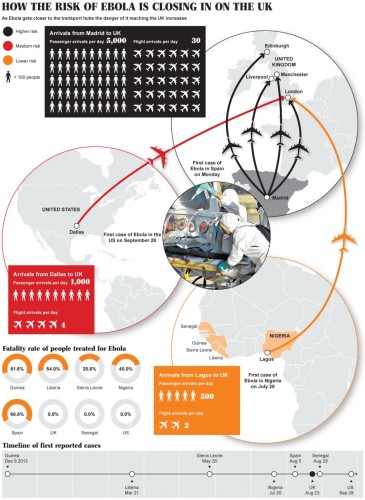 Mail Online recently reported: “Global threat of Ebola: From the US to China, scientists plot spread of deadly disease across the world from its West African hotbed.”. This is a terrifyingly apocalyptic-sounding headline, yet the real story about Ebola is that, while still frightening and deadly, it is still a very low risk to people in the UK.
Mail Online recently reported: “Global threat of Ebola: From the US to China, scientists plot spread of deadly disease across the world from its West African hotbed.”. This is a terrifyingly apocalyptic-sounding headline, yet the real story about Ebola is that, while still frightening and deadly, it is still a very low risk to people in the UK.
The Ebola virus causes a serious, usually fatal, disease, for which there are no licensed treatments or vaccines. An ongoing outbreak of Ebola virus started in the West African country of Guinea, which was first reported in December 2013. This Ebola outbreak is the largest ever observed, both geographically and in terms of the number of people affected.
A study published on September 2 2014 has modelled how the virus may spread. It found that the short-term probability of international spread outside the African region was small, but not negligible. This short-term probability covered three and six weeks, which corresponded to September 1 and 22 2014. The study found that the country outside the African region with the highest risk of importation was the UK.
Those original forecasts have since been revised and will have to be further updated after a Spanish nurse contracted Ebola. This happened after she treated two Spanish missionaries, who died of the disease after being flown back from Africa. This nurse is the first person known to have contracted Ebola outside of West Africa. Her husband and three other people who had contact with her are also in isolation and being closely observed for symptoms of the disease.
Where did the Mail Online story come from?
The study was carried out by researchers from Northeastern University, the Fred Hutchinson Cancer Research Center, and the University of Florida, all in the US, and the Institute for Scientific Interchange in Italy. It was funded by the Defense Threat Reduction Agency and MIDAS-National Institute of General Medical Sciences.
The study was published in the peer-reviewed journal PLOS Current Outbreaks on 2nd September 2014. This is an open access journal, which is freely available to all. The researchers state that the results of their model may change as more information becomes available and are publishing new data, projections and analysis online.
The media has reported the results of the updated projections published on the site above. It’s worth bearing in mind that, despite the very worrying headlines and the deadliness of Ebola, the risk to anyone in the UK is very low.
What kind of research was it?
This was a modelling study that aimed to forecast the local transmission of the Ebola virus in West Africa, and the probability of international spread if the containment measures are not successful at stopping the outbreak.
Like the weather forecast, modelling studies have to contain assumptions and approximations, and although they are useful tools to help predict what might happen, they are not always correct. The assumptions and approximations in this model are being updated by the researchers as new information becomes available.
What did the research involve?
The researchers used computer simulations to model the transmission of the Ebola virus.
What were the basic results?
The researchers estimate that each case of Ebola in West Africa will spread to 1.5 to 2 unaffected people. In the short term (three and six weeks, which corresponded to until September 1 and September 22 2014), the probability of international spread outside the African region was thought to be small, but not negligible. The country outside the African region with the highest risk of importation in the short term was assumed to be the UK (the conclusion was reached prior to the Spanish case).
The outbreak is more likely to spread to other African countries, which will increase the risk of international spread over a longer time period.
How did the researchers interpret the results?
The researchers conclude that their modelling has shown that, “the risk of international spread of the Ebola virus is still moderate for most countries. The current analysis, however, shows that if the outbreak is not contained, the probability of international spread is going to increase consistently, especially if other countries are affected and are not able to contain the epidemic”.
They go on to stress that the current model contains assumptions and approximations that may need to be modified as more information becomes available.
If you are travelling abroad and are worried about infectious diseases, you may want to check out the country-by-country guide provided by the National Travel Health Network and Centre. Source: NHS.uk









